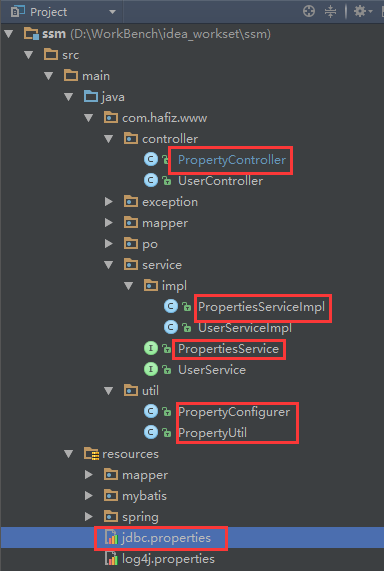2019獨角獸企業重金招聘Python工程師標準>>> 
方式1.通過context:property-placeholder加載配置文件jdbc.properties中的內容
<context:property-placeholder location="classpath:jdbc.properties" ignore-unresolvable="true"/>
上面的配置和下面配置等價,是對下面配置的簡化
<bean id="propertyConfigurer" class="org.springframework.beans.factory.config.PropertyPlaceholderConfigurer"><property name="ignoreUnresolvablePlaceholders" value="true"/><property name="locations"><list><value>classpath:jdbc.properties</value></list></property> </bean>
注意:這種方式下,如果你在spring-mvc.xml文件中有如下配置,則一定不能缺少下面的紅色部分,關于它的作用以及原理,參見另一篇博客:context:component-scan標簽的use-default-filters屬性的作用以及原理分析
<!-- 配置組件掃描,springmvc容器中只掃描Controller注解 --> <context:component-scan base-package="com.hafiz.www" use-default-filters="false"><context:include-filter type="annotation" expression="org.springframework.stereotype.Controller"/> </context:component-scan>
方式2.使用注解的方式注入,主要用在java代碼中使用注解注入properties文件中相應的value值
<bean id="prop" class="org.springframework.beans.factory.config.PropertiesFactoryBean"><!-- 這里是PropertiesFactoryBean類,它也有個locations屬性,也是接收一個數組,跟上面一樣 --><property name="locations"><array><value>classpath:jdbc.properties</value></array></property> </bean>
方式3.使用util:properties標簽進行暴露properties文件中的內容
<util:properties id="propertiesReader" location="classpath:jdbc.properties"/>
注意:使用上面這行配置,需要在spring-dao.xml文件的頭部聲明以下紅色的部分
<beans xmlns="http://www.springframework.org/schema/beans"xmlns:xsi="http://www.w3.org/2001/XMLSchema-instance"xmlns:context="http://www.springframework.org/schema/context"xmlns:util="http://www.springframework.org/schema/util"xsi:schemaLocation="http://www.springframework.org/schema/beanshttp://www.springframework.org/schema/beans/spring-beans-3.2.xsdhttp://www.springframework.org/schema/context http://www.springframework.org/schema/context/spring-context-3.2.xsdhttp://www.springframework.org/schema/util http://www.springframework.org/schema/util/spring-util.xsd">
方式4.通過PropertyPlaceholderConfigurer在加載上下文的時候暴露properties到自定義子類的屬性中以供程序中使用
<bean id="propertyConfigurer" class="com.hafiz.www.util.PropertyConfigurer"><property name="ignoreUnresolvablePlaceholders" value="true"/><property name="ignoreResourceNotFound" value="true"/><property name="locations"><list><value>classpath:jdbc.properties</value></list></property> </bean>
自定義類PropertyConfigurer的聲明如下:
package com.hafiz.www.util;import org.springframework.beans.BeansException; import org.springframework.beans.factory.config.ConfigurableListableBeanFactory; import org.springframework.beans.factory.config.PropertyPlaceholderConfigurer;import java.util.Properties;/*** Desc:properties配置文件讀取類* Created by hafiz.zhang on 2016/9/14.*/ public class PropertyConfigurer extends PropertyPlaceholderConfigurer {private Properties props; // 存取properties配置文件key-value結果 @Overrideprotected void processProperties(ConfigurableListableBeanFactory beanFactoryToProcess, Properties props)throws BeansException {super.processProperties(beanFactoryToProcess, props);this.props = props;}public String getProperty(String key){return this.props.getProperty(key);}public String getProperty(String key, String defaultValue) {return this.props.getProperty(key, defaultValue);}public Object setProperty(String key, String value) {return this.props.setProperty(key, value);} }
使用方式:在需要使用的類中使用@Autowired注解注入即可。
方式5.自定義工具類PropertyUtil,并在該類的static靜態代碼塊中讀取properties文件內容保存在static屬性中以供別的程序使用
package com.hafiz.www.util;import org.slf4j.Logger; import org.slf4j.LoggerFactory;import java.io.*; import java.util.Properties;/*** Desc:properties文件獲取工具類* Created by hafiz.zhang on 2016/9/15.*/ public class PropertyUtil {private static final Logger logger = LoggerFactory.getLogger(PropertyUtil.class);private static Properties props;static{loadProps();}synchronized static private void loadProps(){logger.info("開始加載properties文件內容.......");props = new Properties();InputStream in = null;try {<!--第一種,通過類加載器進行獲取properties文件流-->in = PropertyUtil.class.getClassLoader().getResourceAsStream("jdbc.properties");<!--第二種,通過類進行獲取properties文件流-->//in = PropertyUtil.class.getResourceAsStream("/jdbc.properties"); props.load(in);} catch (FileNotFoundException e) {logger.error("jdbc.properties文件未找到");} catch (IOException e) {logger.error("出現IOException");} finally {try {if(null != in) {in.close();}} catch (IOException e) {logger.error("jdbc.properties文件流關閉出現異常");}}logger.info("加載properties文件內容完成...........");logger.info("properties文件內容:" + props);}public static String getProperty(String key){if(null == props) {loadProps();}return props.getProperty(key);}public static String getProperty(String key, String defaultValue) {if(null == props) {loadProps();}return props.getProperty(key, defaultValue);} }
說明:這樣的話,在該類被加載的時候,它就會自動讀取指定位置的配置文件內容并保存到靜態屬性中,高效且方便,一次加載,可多次使用。
四、注意事項及建議
以上五種方式,前三種方式比較死板,而且如果你想在帶有@Controller注解的Bean中使用,你需要在SpringMVC的配置文件spring-mvc.xml中進行聲明,如果你想在帶有@Service、@Respository等非@Controller注解的Bean中進行使用,你需要在Spring的配置文件中spring.xml中進行聲明。原因請參見另一篇博客:Spring和SpringMVC父子容器關系初窺
我個人比較建議第四種和第五種配置方式,第五種為最好,它連工具類對象都不需要注入,直接調用靜態方法進行獲取,而且只一次加載,效率也高。而且前三種方式都不是很靈活,需要修改@Value的鍵值。
五、測試驗證是否可用
1.首先我們創建PropertiesService
package com.hafiz.www.service;/*** Desc:java程序獲取properties文件內容的service* Created by hafiz.zhang on 2016/9/16.*/ public interface PropertiesService {/*** 第一種實現方式獲取properties文件中指定key的value** @return*/String getProperyByFirstWay();/*** 第二種實現方式獲取properties文件中指定key的value** @return*/String getProperyBySecondWay();/*** 第三種實現方式獲取properties文件中指定key的value** @return*/String getProperyByThirdWay();/*** 第四種實現方式獲取properties文件中指定key的value** @param key** @return*/String getProperyByFourthWay(String key);/*** 第四種實現方式獲取properties文件中指定key的value** @param key** @param defaultValue** @return*/String getProperyByFourthWay(String key, String defaultValue);/*** 第五種實現方式獲取properties文件中指定key的value** @param key** @return*/String getProperyByFifthWay(String key);/*** 第五種實現方式獲取properties文件中指定key的value** @param key** @param defaultValue** @return*/String getProperyByFifthWay(String key, String defaultValue); }
2.創建實現類PropertiesServiceImpl
package com.hafiz.www.service.impl;import com.hafiz.www.service.PropertiesService; import com.hafiz.www.util.PropertyConfigurer; import com.hafiz.www.util.PropertyUtil; import org.springframework.beans.factory.annotation.Autowired; import org.springframework.beans.factory.annotation.Value; import org.springframework.stereotype.Service;/*** Desc:java程序獲取properties文件內容的service的實現類* Created by hafiz.zhang on 2016/9/16.*/ @Service public class PropertiesServiceImpl implements PropertiesService {@Value("${test}")private String testDataByFirst;@Value("#{prop.test}")private String testDataBySecond;@Value("#{propertiesReader[test]}")private String testDataByThird;@Autowiredprivate PropertyConfigurer pc;@Overridepublic String getProperyByFirstWay() {return testDataByFirst;}@Overridepublic String getProperyBySecondWay() {return testDataBySecond;}@Overridepublic String getProperyByThirdWay() {return testDataByThird;}@Overridepublic String getProperyByFourthWay(String key) {return pc.getProperty(key);}@Overridepublic String getProperyByFourthWay(String key, String defaultValue) {return pc.getProperty(key, defaultValue);}@Overridepublic String getProperyByFifthWay(String key) {return PropertyUtil.getPropery(key);}@Overridepublic String getProperyByFifthWay(String key, String defaultValue) {return PropertyUtil.getProperty(key, defaultValue);} }
3.控制器類PropertyController
package com.hafiz.www.controller;import com.hafiz.www.service.PropertiesService; import com.hafiz.www.util.PropertyUtil; import org.springframework.beans.factory.annotation.Autowired; import org.springframework.stereotype.Controller; import org.springframework.web.bind.annotation.PathVariable; import org.springframework.web.bind.annotation.RequestMapping; import org.springframework.web.bind.annotation.RequestMethod; import org.springframework.web.bind.annotation.ResponseBody;/*** Desc:properties測試控制器* Created by hafiz.zhang on 2016/9/16.*/ @Controller @RequestMapping("/prop") public class PropertyController {@Autowiredprivate PropertiesService ps;@RequestMapping(value = "/way/first", method = RequestMethod.GET)@ResponseBodypublic String getPropertyByFirstWay(){return ps.getProperyByFirstWay();}@RequestMapping(value = "/way/second", method = RequestMethod.GET)@ResponseBodypublic String getPropertyBySecondWay(){return ps.getProperyBySecondWay();}@RequestMapping(value = "/way/third", method = RequestMethod.GET)@ResponseBodypublic String getPropertyByThirdWay(){return ps.getProperyByThirdWay();}@RequestMapping(value = "/way/fourth/{key}", method = RequestMethod.GET)@ResponseBodypublic String getPropertyByFourthWay(@PathVariable("key") String key){return ps.getProperyByFourthWay(key, "defaultValue");}@RequestMapping(value = "/way/fifth/{key}", method = RequestMethod.GET)@ResponseBodypublic String getPropertyByFifthWay(@PathVariable("key") String key){return PropertyUtil.getProperty(key, "defaultValue");} }
4.jdbc.properties文件
jdbc.driver=com.mysql.jdbc.Driver jdbc.url=jdbc:mysql://192.168.1.196:3306/dev?useUnicode=true&characterEncoding=UTF-8 jdbc.username=root jdbc.password=123456 jdbc.maxActive=200 jdbc.minIdle=5 jdbc.initialSize=1 jdbc.maxWait=60000 jdbc.timeBetweenEvictionRunsMillis=60000 jdbc.minEvictableIdleTimeMillis=300000 jdbc.validationQuery=select 1 from t_user jdbc.testWhileIdle=true jdbc.testOnReturn=false jdbc.poolPreparedStatements=true jdbc.maxPoolPreparedStatementPerConnectionSize=20 jdbc.filters=stat #test data test=com.hafiz.www
5.項目結果圖

6.項目GitHub地址
https://github.com/hafizzhang/SSM/branches?頁面下的propertiesConfigurer分支。
7.測試結果
第一種方式

第二種方式

第三種方式

第四種方式

第五種方式

六、總結
通過本次的梳理和測試,我們理解了Spring和SpringMVC的父子容器關系以及context:component-scan標簽包掃描時最容易忽略的use-default-filters屬性的作用以及原理。能夠更好地定位和快速解決再遇到的問題。總之,棒棒噠~~~




![[SDOI2008]Cave 洞穴勘測](http://pic.xiahunao.cn/[SDOI2008]Cave 洞穴勘測)



![[MS Sql Server術語解釋]預讀,邏輯讀,物理讀](http://pic.xiahunao.cn/[MS Sql Server術語解釋]預讀,邏輯讀,物理讀)


)
)





...)
